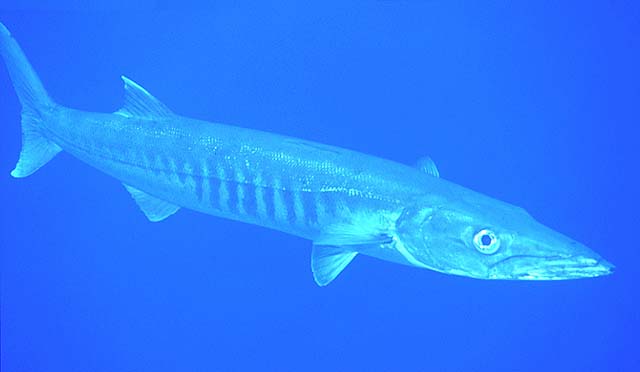| Sphyraenidae (Barracudas) |
| 200 cm TL (male/unsexed); max.weight: 50 kg; max. reported age: 18 years |
|
reef-associated; brackish; marine; depth range 0 - 100 m |
| Indo-Pacific: Red Sea and east coast of Africa to Hawaii and the Marquesas and Tuamoto islands. Western Atlantic: Massachusetts (USA), Bermuda, and throughout the Caribbean Sea to Brazil (Ref. 9626). Eastern Atlantic: Sierra Leone, Côte d'Ivoire, Togo, Nigeria, Senegal (Ref. 6949), Mauritania (Ref. 5377), St. Paul's Rocks (Ref. 13121), and São Tomé Island (Ref. 34088). |
|
Dorsal spines (total): 6-6; Dorsal soft rays (total): 9-9; Anal spines: 2-2; Anal soft rays: 8-8. This species is distinguished by the following characters: a large body, large eyes; body depth 6.0-8.2 in SL; teeth erect and contiguous; no gill rakers on first gill arch, instead upper and lower gill arch with rough platelets which lack distinct spines; origin of first dorsal fin at level of the rear base of the pelvic fins; caudal fin emarginate with a pair of large lobes at posterior margin, except young less than 50 cm TL which have a forked caudal fin. Colour of body silvery; many oblique dark bars on upper half of body that do not across lateral line; caudal fin black with white tips; juveniles with a series of large dark blotches irregularly arranged on sides of body (Ref. 9768, 90102). |
| Found predominantly at or near the surface (Ref. 6949, 48637). Juvenile occurs among mangroves, estuaries and shallow sheltered inner reef areas; adult occurs in a wide range of habitats from murky inner harbors to open seas. Diurnal and solitary, but can also be found in small aggregations. Feeds on fishes, cephalopods and sometimes on shrimps (Ref. 9626, 48637). Sold fresh. Utilized also dried or salted (Ref. 9987). Although this species is ciguatoxic elsewhere throughout its range, it has not been reported to be poisonous in the eastern Atlantic (Ref. 6949, 48637). Rarely attacks humans, usually with one quick, fierce strike, which, although serious, is rarely fatal. The world's record on hook and line is a 5.5-ft. fish taken in the Bahamas that weighed 103 lbs. (Ref. 13442). Caught by handline, set nets, and other fishing gear (Ref. 9768). Minimum depth reported taken from Ref. 128797. |
|
Least Concern (LC); Date assessed: 29 January 2013 Ref. (130435)
|
| traumatogenic |
Source and more info: www.fishbase.org. For personal, classroom, and other internal use only. Not for publication.

